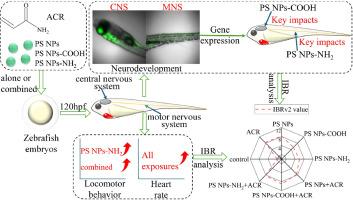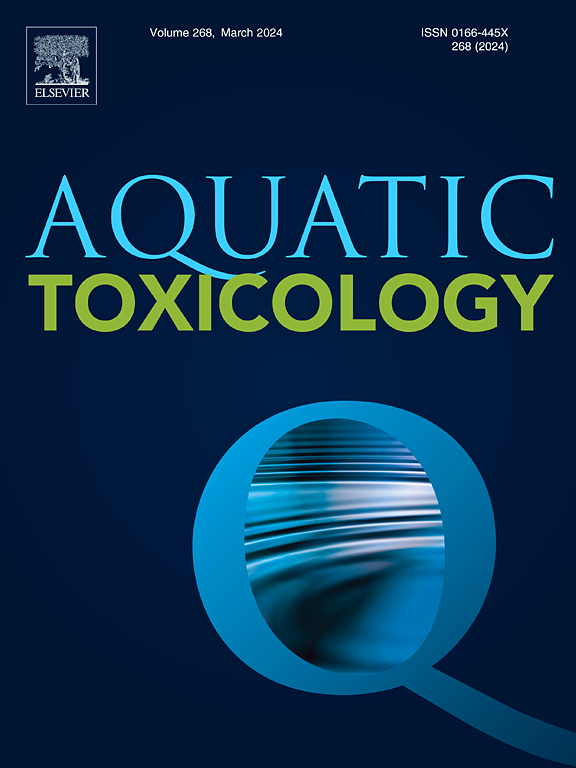Effect of functional groups of polystyrene nanoplastics on the neurodevelopmental toxicity of acrylamide in the early life stage of zebrafish
IF 4.1
2区 环境科学与生态学
Q1 MARINE & FRESHWATER BIOLOGY
引用次数: 0
Abstract
Polystyrene nanoplastics (PS NPs) and acrylamide (ACR), both emerging contaminants, have been found to be related to neurotoxicity. However, the effects of PS NPs on ACR-induced neurodevelopmental toxicity remain unclear. In this study, anionic carboxyl polystyrene nanoplastics (PS NPs-COOH), cationic amino polystyrene nanoplastics (PS NPs-NH2) and unmodified PS NPs were selected to investigate their interaction with ACR. A serious of the neurotoxicity biomarkers from individual to molecular level were evaluated to explore the specific mechanisms. The results indicated that the unmodified PS NPs had the most significant impact on embryonic development at low concentrations in combination with ACR. The toxicity of the other two functionalized PS NPs increased with concentration, exhibiting a clear dose-response relationship. Meanwhile, all three kinds of PS NPs significantly enhanced the impacts of ACR on the locomotion behavior of zebrafish larvae. Analysis of zebrafish nervous system development showed that PS NPs-COOH exhibit greater toxicity to the central nervous system. In contrast, PS NPs-NH2 had a more significant impact on the motor nervous system. Gene expression analysis revealed that ACR and PS NPs significantly affected the expression levels of neurodevelopmental related genes, including Neurog1, Elavl3, Gfap, Gap43, Mbpa, Shha. PS NPs modified with functional groups could induce corresponding neurotoxicity by affecting genes expression related to neuronal differentiation, motor neuron, and axonal development. Based on the comprehensive biomarker response index, the order of the impacts of NPs on the neurotoxicity of ACR was PS NPs-COOH > PS NPs-NH2 > PS NPs. In conclusion, this study provides new insights into the interactive biological effects of NPs and ACR on zebrafish embryo, contributing to a better understanding of their environmental risk to aquatic ecosystem.

聚苯乙烯纳米塑料的官能团对斑马鱼早期丙烯酰胺神经发育毒性的影响
聚苯乙烯纳米塑料(PS NPs)和丙烯酰胺(ACR)都是新兴的污染物,已被发现与神经毒性有关。然而,PS NPs对acr诱导的神经发育毒性的影响尚不清楚。本研究选择阴离子羧基聚苯乙烯纳米塑料(PS NPs- cooh)、阳离子氨基聚苯乙烯纳米塑料(PS NPs- nh2)和未改性聚苯乙烯纳米塑料(PS NPs),研究它们与ACR的相互作用。从个体到分子水平的一系列神经毒性生物标志物进行了评估,以探讨其具体机制。结果表明,在低浓度与ACR联合作用下,未修饰的PS NPs对胚胎发育的影响最为显著。另外两种功能化PS NPs的毒性随浓度的增加而增加,表现出明显的量效关系。同时,三种PS NPs均显著增强了ACR对斑马鱼幼虫运动行为的影响。斑马鱼神经系统发育分析表明,PS NPs-COOH对中枢神经系统具有更大的毒性。相比之下,PS NPs-NH2对运动神经系统的影响更为显著。基因表达分析显示,ACR和PS NPs显著影响神经发育相关基因Neurog1、Elavl3、Gfap、Gap43、Mbpa、Shha的表达水平。经过官能团修饰的PS NPs可通过影响神经元分化、运动神经元和轴突发育相关基因的表达诱导相应的神经毒性。综合生物标志物反应指数,NPs对ACR神经毒性的影响顺序为:PS NPs- cooh >;PS NPs-NH2 >;PS NPs。综上所述,本研究为NPs和ACR对斑马鱼胚胎的交互生物学效应提供了新的见解,有助于更好地了解它们对水生生态系统的环境风险。
本文章由计算机程序翻译,如有差异,请以英文原文为准。
求助全文
约1分钟内获得全文
求助全文
来源期刊

Aquatic Toxicology
环境科学-毒理学
CiteScore
7.10
自引率
4.40%
发文量
250
审稿时长
56 days
期刊介绍:
Aquatic Toxicology publishes significant contributions that increase the understanding of the impact of harmful substances (including natural and synthetic chemicals) on aquatic organisms and ecosystems.
Aquatic Toxicology considers both laboratory and field studies with a focus on marine/ freshwater environments. We strive to attract high quality original scientific papers, critical reviews and expert opinion papers in the following areas: Effects of harmful substances on molecular, cellular, sub-organismal, organismal, population, community, and ecosystem level; Toxic Mechanisms; Genetic disturbances, transgenerational effects, behavioral and adaptive responses; Impacts of harmful substances on structure, function of and services provided by aquatic ecosystems; Mixture toxicity assessment; Statistical approaches to predict exposure to and hazards of contaminants
The journal also considers manuscripts in other areas, such as the development of innovative concepts, approaches, and methodologies, which promote the wider application of toxicological datasets to the protection of aquatic environments and inform ecological risk assessments and decision making by relevant authorities.
 求助内容:
求助内容: 应助结果提醒方式:
应助结果提醒方式:


